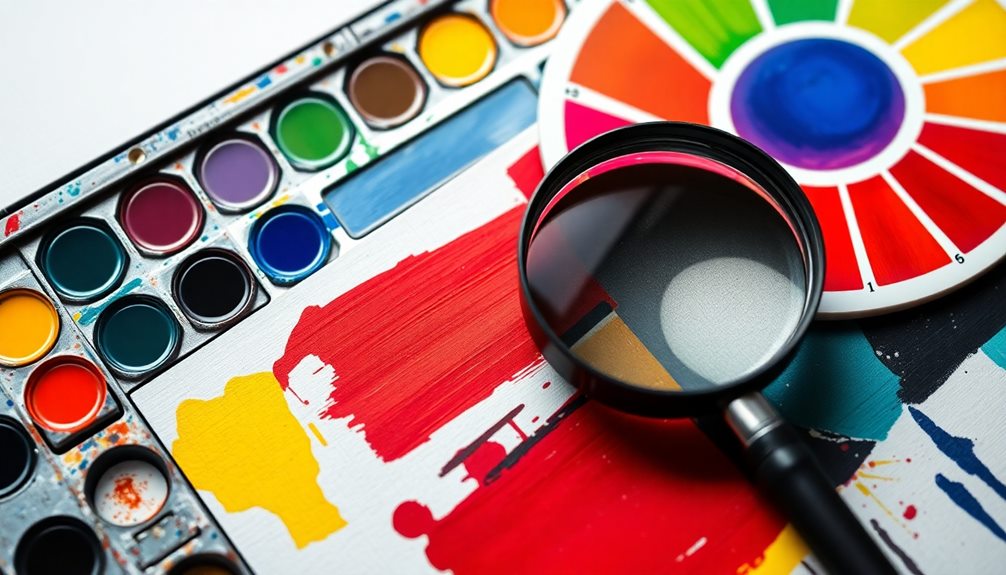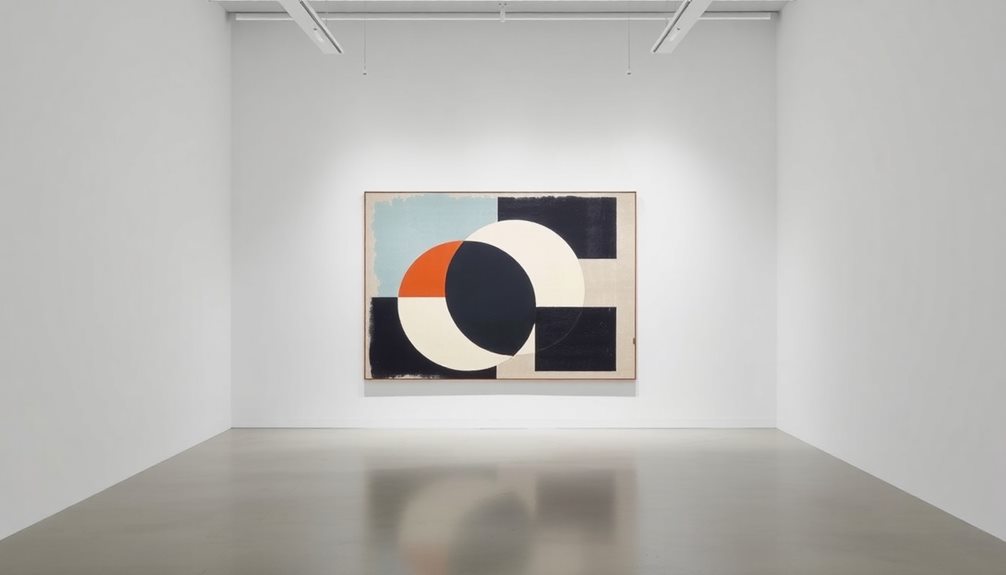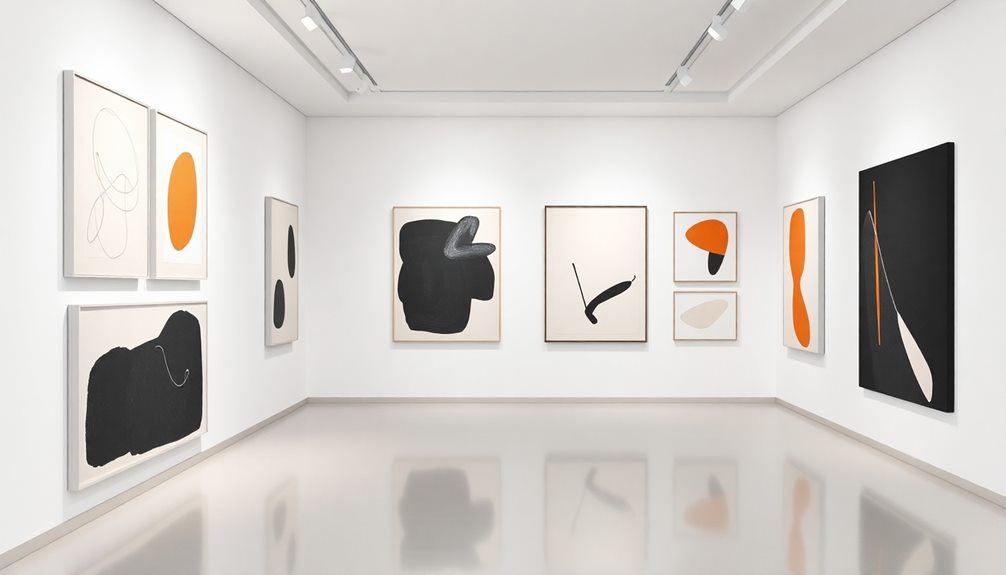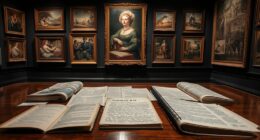To analyze an artwork using formalist theory, start by focusing on its visual elements: lines, shapes, colors, and textures. Observe the artwork closely for at least 20 minutes, noting how these elements interact. Assess the composition, looking for balance, symmetry, and focal points. Evaluate the color scheme to understand its emotional tone and dynamics. Pay attention to the texture and how it affects perception. Keep your analysis objective, avoiding personal biases. By following this structured approach, you'll uncover deeper meanings within the artwork, and there's plenty more to explore about enhancing your formal analysis skills.
Key Takeaways
- Focus on visual elements such as line, color, shape, and texture to conduct a formal analysis of the artwork.
- Dedicate at least 20 minutes for close observation to thoroughly examine the artwork's formal components.
- Analyze the composition by assessing balance, unity, symmetry, and focal points to understand the overall structure.
- Utilize precise art terminology to articulate your observations and maintain an objective tone throughout the analysis.
- Reflect on personal biases and engage diverse perspectives to enrich the formal analysis and uncover deeper insights.
Introduction
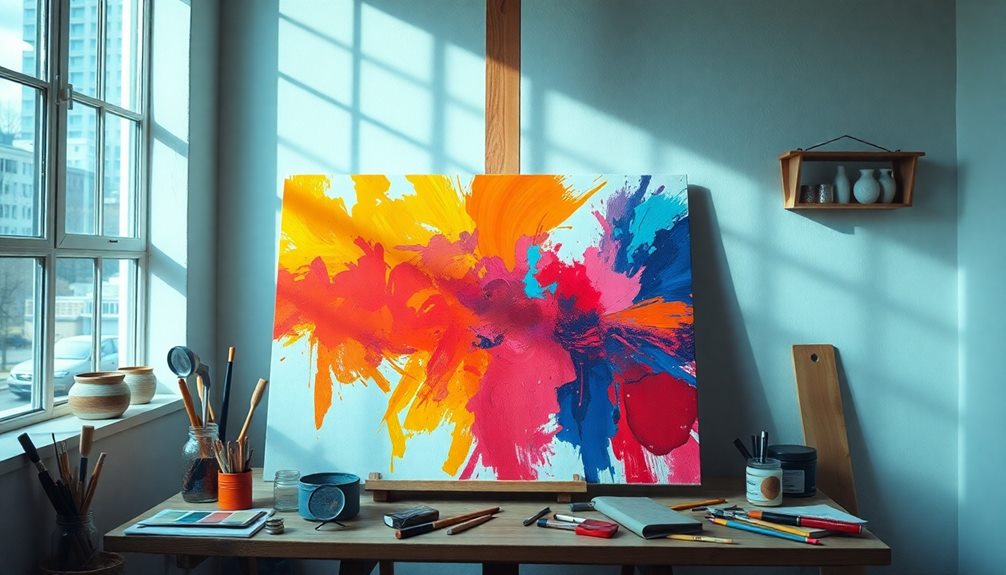
When you dive into analyzing an artwork through formalist theory, you'll focus on its visual elements rather than external influences. This approach emphasizes the intrinsic qualities of a work of art, allowing you to explore how elements like line, color, shape, and composition interact to create meaning.
To begin your formal analysis, dedicate at least 20 minutes to observe the artwork closely. During this time, note the formal elements and their relationships, which will form the foundation of your analysis.
As you dissect the artwork, pay attention to key components such as balance, contrast, and movement. These elements significantly contribute to the overall composition and affect the viewer's experience. For instance, in contemporary Indian painting, artists often use mixed media to enhance depth, making the formal analysis even more engaging urban themes reflect modernization.
Remember to maintain an objective tone throughout your analysis, avoiding personal impressions. Instead, concentrate on how the artwork's formal qualities convey meaning.
A structured approach is essential. Start with a clear thesis statement that encapsulates your main argument, and ensure your supporting claims are drawn directly from the visual evidence within the artwork.
Key Concepts and Definitions

Formalist theory revolves around the critical examination of an artwork's visual elements, prioritizing aspects like line, color, shape, and texture. This approach emphasizes the importance of these formal elements in constructing meaning, as they influence the viewer's perception and emotional response.
Understanding the importance of art theory in creativity can further enhance your analysis by providing a broader context for the artwork's formal components.
Key concepts in formalist analysis include the relationship between line and shape, which can create structure and define space within the piece. You'll also consider value contrasts that enhance depth and bring dimension to the artwork.
Understanding composition is crucial; it involves analyzing how the arrangement of elements creates balance and unity.
Formal Analysis Framework

How can you effectively analyze an artwork using a formal analysis framework? Start by observing the artwork closely, noting the formal elements like line, shape, color, and texture. These elements serve as the foundation for your analysis.
Additionally, consider how certain colors or textures might evoke specific emotions, much like how essential oils for toothache relief can influence physical sensations.
Next, dive into the composition by examining how the arrangement of these elements contributes to the overall structure and balance. Look for the use of space and identify focal points that guide your eye through the piece.
Consider the color schemes employed by the artist. How do they affect the emotional tone or visual dynamics? Take note of any contrasts or harmonies that stand out.
Don't overlook the techniques used, such as brushwork or mark-making, as these can provide valuable insights into the texture and depth of the artwork.
Famous Artworks Analyzed Individually

Analyzing famous artworks individually reveals the unique techniques and emotional depths that each artist brings to their work.
Take *The Milkmaid* by Vermeer, for example. Its use of natural light enhances the figure's presence, directing your gaze to the pouring milk. The composition employs diagonal lines that highlight this action, creating a dynamic visual experience.
In contrast, Van Gogh's *Starry Night* captivates with swirling forms and a vibrant color palette that convey emotional intensity. The interplay of blues and yellows establishes a dynamic visual rhythm, pulling you into the scene.
Salvador Dalí's *The Persistence of Memory* presents a surreal analysis of time with its melting clocks. The dreamlike landscape and realistic details challenge your perceptions of reality, inviting deeper contemplation.
Vermeer's *The Girl with a Pearl Earring* stands out for its striking use of light and shadow, creating depth that highlights the subject's enigmatic expression. The rich color contrasts enhance the painting's emotional impact, making it unforgettable.
Tips and Best Practices
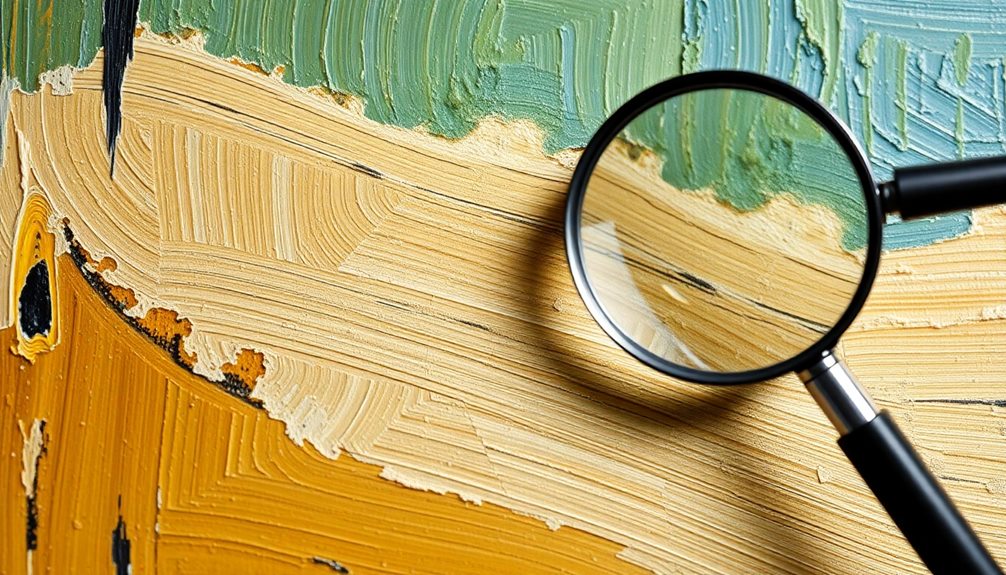
To effectively analyze an artwork through the lens of formalist theory, start by immersing yourself in the piece for at least 20 minutes. During this time, focus on observing the formal elements of the work, such as line, color, shape, and texture. This foundational understanding sets the stage for deeper analysis.
Next, analyze the composition by examining the design principles at play, including balance, contrast, and movement. Consider how these elements work together to enhance the overall visual impact of the artwork. Use precise art terminology to describe your observations; clear communication helps maintain objectivity and avoids personal biases.
As you delve deeper, identify relationships between different formal elements. For example, explore how color schemes interact or how lines direct the viewer's gaze. This can reveal deeper meanings and insights about the piece.
Audience Engagement and Feedback

Engaging your audience in the analysis of formal elements like line, color, and composition can spark lively discussions and reveal diverse interpretations of the artwork. This audience engagement plays an important role in deepening their understanding of the works of art.
When you encourage viewers to share their thoughts, you open up pathways for varied insights and emotional responses that enhance the overall analysis.
Incorporating audience questions during presentations fosters interactive dialogue, allowing participants to explore the artwork's formal aspects more deeply. This collaboration can lead to richer discussions and a more profound appreciation of the piece.
Additionally, collecting feedback through surveys or forms after your analysis can help you gauge audience comprehension and interest in specific elements.
Creating opportunities for reflection, such as journaling or group discussions, also encourages personal connections to the artwork. These activities allow viewers to articulate their feelings and thoughts, contributing to a more comprehensive analysis.
Interpretation Biases and Perspectives

Many viewers unknowingly carry interpretation biases shaped by their personal experiences and cultural backgrounds, which can significantly influence how they perceive formal elements in an artwork. These biases can lead you to focus on certain aspects of the piece, possibly overshadowing others.
For instance, your understanding of an artwork's composition—like its lines, colors, and shapes—can vary drastically based on your background.
Formalist theory emphasizes the importance of analyzing an artwork's intrinsic qualities, helping you concentrate on visual evidence rather than external context or emotions. By recognizing your own interpretation biases, you can achieve a more objective assessment of the formal elements at play.
This self-awareness allows you to appreciate how these elements impact your perception. Engaging with diverse perspectives is also vital in this process. By considering various interpretations, you enrich your analysis, uncovering insights that mightn't have been apparent through your lens alone.
This collaborative approach not only broadens your understanding of the artwork but also highlights the richness and complexity inherent in its formal aspects. Ultimately, acknowledging biases and embracing diverse viewpoints can enhance your formal analysis experience.
Additional Resources

There are plenty of resources available to help you deepen your understanding of formalist theory and enhance your analysis of artworks. Online platforms like Khan Academy and SmartHistory offer free video tutorials and interactive lessons focused on the formal analysis of art. These can serve as a great starting point for anyone eager to learn.
For a more structured approach, consider reading "Art History: A Very Short Introduction" by Dana Arnold. This book provides concise overviews of formalist theory and its application, making it easier to grasp key concepts.
Additionally, museums like The Metropolitan Museum of Art and the Museum of Modern Art offer educational materials and guided tours that emphasize formal analysis techniques, helping students connect theory with real-world examples.
You can also explore the Getty Institute's website, where you'll find lesson plans that illustrate how to use formal elements in analyzing artworks at various educational levels.
Lastly, academic journals like "The Art Bulletin" publish articles discussing formalist theory and provide in-depth case studies. These resources can significantly enhance your understanding and help you identify the focal points in artworks, improving your analysis skills.
Frequently Asked Questions
What Are the Steps of Formal Analysis of Art?
To analyze art formally, you observe for details, assess color schemes, examine composition, explore spatial qualities, and synthesize your observations. Each step helps uncover the artwork's deeper themes and overall impact.
What Is the Formalist Method of Analysis?
The formalist method of analysis focuses on visual elements like line, color, and shape. You examine these components to understand how they interact, shaping your perception and appreciation of the artwork's structure and design.
How Do You Analyse Art Step by Step?
To analyze art step by step, start by observing the piece closely. Note its elements like color and shape, then consider how they interact. Finally, synthesize your observations to understand the artwork's overall impact.
What Factors Are Considered in a Formalist Analysis of Artwork?
In a formalist analysis, you consider visual elements like line, shape, color, and texture. You also focus on composition, balance, contrast, and the arrangement of these elements to understand their impact on viewer perception.
Conclusion
By applying formalist theory, you can deepen your understanding of art and enhance your appreciation for its intricacies. Remember to focus on the elements of form, such as color, line, and composition, as you analyze each piece. Don't hesitate to explore famous artworks and practice your skills with the tips provided. Engaging with art in this way can transform your viewing experience, allowing you to uncover layers of meaning you might have otherwise missed.
